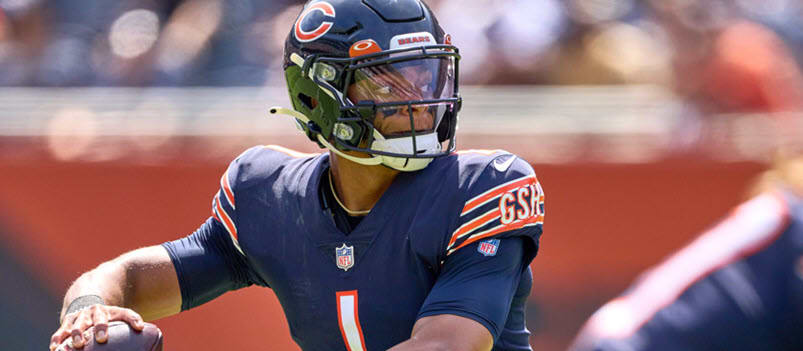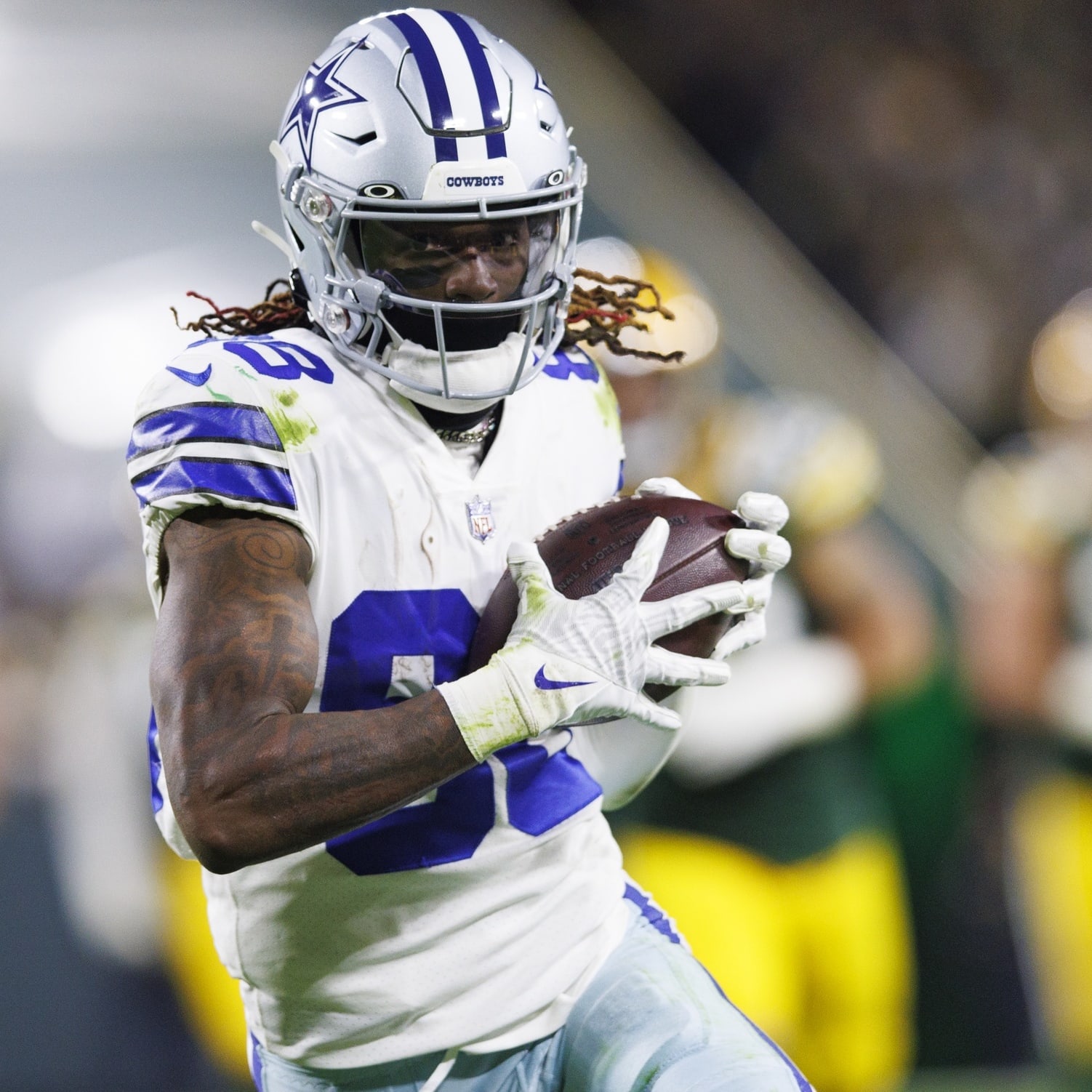This article is part of our NFL Barometer series.
Advanced stats are a quick way to spark debate in the fantasy football community. While no single factor will ever provide a simple answer about the potential for a player, advanced stats are among a number of data points that can help us gain a more accurate idea of the range of potential outcomes. That's the goal in this week's edition of the Barometer, as I picked through some of the advanced stats on RotoWire, Pro Football Reference and NFL Next Gen stats to make the case for and against several players.
Risers
Justin Fields, Bears
Fields isn't being drafted as a starter in single-quarterback leagues on any of the major fantasy platforms, and it's hard to argue that drafters are making a mistake. He averaged only 6.9 yards per attempt (20th among quarterbacks) and completed an abysmal 59 percent of his passes in 2021. Projections don't improve that outlook much either, as the Bears arguably have among the worst group of skill players and offensive line in the league.
Before we bury Fields as a potential real-life bust and as a fantasy disappointment, there are some encouraging things to note. Fields was third among qualified passers with 9.5 air yards per pass attempt. Despite his generally poor accuracy, he led qualified passers in average completed air yards. This tells us he wasn't afraid to push the ball down the field, and that when he did so, he was fairly accurate.
Add his 35 rushing yards per game,
Advanced stats are a quick way to spark debate in the fantasy football community. While no single factor will ever provide a simple answer about the potential for a player, advanced stats are among a number of data points that can help us gain a more accurate idea of the range of potential outcomes. That's the goal in this week's edition of the Barometer, as I picked through some of the advanced stats on RotoWire, Pro Football Reference and NFL Next Gen stats to make the case for and against several players.
Risers
Justin Fields, Bears
Fields isn't being drafted as a starter in single-quarterback leagues on any of the major fantasy platforms, and it's hard to argue that drafters are making a mistake. He averaged only 6.9 yards per attempt (20th among quarterbacks) and completed an abysmal 59 percent of his passes in 2021. Projections don't improve that outlook much either, as the Bears arguably have among the worst group of skill players and offensive line in the league.
Before we bury Fields as a potential real-life bust and as a fantasy disappointment, there are some encouraging things to note. Fields was third among qualified passers with 9.5 air yards per pass attempt. Despite his generally poor accuracy, he led qualified passers in average completed air yards. This tells us he wasn't afraid to push the ball down the field, and that when he did so, he was fairly accurate.
Add his 35 rushing yards per game, and Fields is a strong No. 2 quarterback to take a chance on late in a draft. Consider pairing him with a safer, and lower ceiling, top-option such as Aaron Rodgers, Matthew Stafford or Derek Carr.
Rashaad Penny, Seahawks
Particularly when scouting a rookie class, we regularly see yards after contact cited as a desirable metric for running backs. That makes sense, but we also want backs to miss contact altogether. Penny has shown the ability to do both, as he averaged 3.2 yards before contact (third in the league) and 3.1 yards after contact (first in the league.). Per NFL Next Gen Stats, he also finished first in the league with 2.1 yards over expectation per attempt.
It is important to give context to those numbers. Penny finished with only 119 rushing attempts last season, while the qualified running back with the fewest number of carries had 96 carries. If he gets a higher workload, the efficiency could reasonably be expected to fall. Injury risk will always be a part of Penny's profile. Another obvious, negative for Penny is his team context as Seattle's offense is likely to be truly abysmal (unless they land Jimmy Garoppolo).
Because of the downside cited, Penny requires a relatively small investment to acquire in drafts. He has the talent to return well more value than his draft slot, particularly if he gets the chance to work as the workhorse back with Kenneth Walker sidelined to begin the season.
Brandon Aiyuk, 49ers
From a fantasy perspective, Aiyuk and Deebo Samuel aren't viewed as remotely similar, but that might be a mistake. Aiyuk had a 21.1 percent share of the 49ers' targeted air yards in 2021, while Samuel had a 26.61 percent mark. While that leans Samuel's way by a fairly significant margin, it paints the two receivers as more of a 1A and 1B tandem, rather than as a true alpha and second receiver.
This is another situation where we can't simply take those numbers at face value. Aiyuk had more than five targets only once through the 49ers' first six games in 2021. From there, he seemingly got out of coach Kyle Shanahan's dog house and averaged 5.9 targets per game for the rest of the season, including the playoffs. Aiyuk has reportedly impressed teammates during training camp, so the hope would be he can get off to a faster start in 2022.
It's also important to put Samuel's 26.6 percent share into perspective as well. From Weeks 1-9, Samuel saw only four combined rushing attempts and averaged 10 targets per game. From Week 10 forward, he averaged nearly 10 rush attempts per game, but targets fell to only 4.9 per game. Assuming the team respects his wishes to be less involved as a rusher, Samuel should see renewed volume as a receiver.
To wrap that up simply, Samuel is the top pass catcher in the offense, but Aiyuk is undervalued.
Courtland Sutton, Broncos
The potential match between Sutton and Russell Wilson is strong on paper. Sutton finished second to only Marquez Valdes-Scantling in average air yards per target at 15.4. Despite that, he recorded only nine receptions of 20 yards or more, largely because Teddy Bridgewater and Drew Lock were delivering the passes. The addition of Russell Wilson will naturally boost Sutton's efficiency, but Wilson also loves the deep ball. Despite battling a hand injury that appeared to hamper his performance down the stretch in 2021, Wilson averaged 5.5 attempts of 20 yards or more in the air last season — highest-among qualified quarterbacks.
Mo Alie-Cox, Colts
Alie-Cox is big and athletic, but he had regularly operated behind or in complement to Jack Doyle in previous seasons. Doyle is now out of the picture, but the Colts drafted tight ends Jelani Woods and Andrew Ogletree (though Ogletree is already out for the season). Kylen Granson is also in the mix, so the snap and target output should be monitored to begin the season.
Assuming Alie-Cox gets an opportunity, he'll be worth paying attention to. He had an aDOT of 9.6 and was targeted on 19.5 percent of the routes he ran in 2021. If he improves on his snap rate of roughly 55 percent, he should have the chance to enter the mix as a top-20 tight end. He won't be a fantasy star, but he should be a viable play for those who strategically choose to draft tight ends late, or get caught without one.
Fallers
Patrick Mahomes, Chiefs
Mahomes ranked fifth in fantasy points per game among quarterbacks last season, but he accomplished that primarily based on volume. He averaged only 4.8 air yards per completion in 2021 after posting 6.3 and 6.2 in 2020 and 2019, respectively. That manifested itself in surface stats, as he completed 59 passes of 20 or more yards in 17 games last season. In 2020, that number was 67 (in only 15 games). Add the loss of Tyreek Hill and Mahomes' relative lack of rushing upside and there's a case that he should be drafted more in the range of Aaron Rodgers and less in the range of Josh Allen.
Rondale Moore, Cardinals
Coach Kliff Kingsbury took partial ownership for Moore's disappointing rookie season and has since vowed to get him more involved in the offense. However, Moore was such an outlier in several stats that it raises a red flag that he'll ever be able to be productive in the NFL. Most egregious is his aDOT of 1.5. Only four players had lower marks, including fantasy superstars such as Greg Dortch, Easop Winston and Phillip Dorsett. Whether that was caused by Kingsbury's lack of creativity or something missing from Moore's profile is not yet clear. It'll take a huge jump for him to be fantasy relevant in 2022, even with DeAndre Hopkins sidelined for the first six games.
Alvin Kamara, Saints
Kamara saw a career-high 240 rushes in 2021 but managed only 898 yards on the ground. That was comparable to his yardage output in 2018 — his rookie season — when he had 46 fewer attempts. According to NFL Next Gen Stats, Kamara finished last in rushing yards over expectation as a raw total (-133) and fifth lowest on a per attempt basis (-0.56). That stands in stark contrast to his marks in 2020 (101 yards over expectation, 0.55 over expectation per rush), which suggests his effectiveness as a runner legitimately fell last season.
There is still a strong case in Kamara's favor. He should be heavily involved in the passing game and will have extensive involvement in the Saints' offense. Because of that, he isn't necessarily a bad investment late in the second round, but his advanced stats do indicate a return to his 2020 form shouldn't be the expectation.
Rashod Bateman, Ravens
It's no secret that Baltimore wants to run its offense through the ground game, a factor Bateman detractors often cite. However, with the departure of Marquise Brown, there should be plenty of volume for both Mark Andrews and Bateman to deliver big stat lines. The problem for Bateman is that he simply wasn't efficient as a rookie. In addition to seeing only seven deep targets (8.0 aDOT), Bateman also averaged only 3.9 yards after the catch. Put together, he didn't prove to be a viable deep threat, and he wasn't particularly strong with the ball in his hands. It's reasonable to expect improvement as he heads into his second year, but his current ADP is already building in that growth, leaving little room for profit.
Tyler Higbee, Rams
Drafters are already onto the fact that Higbee isn't a great target at tight end, and nearly any statistic will support his current ADP. While he commanded targets at a respectable rate last season, he saw only two targets of 20 or more yards downfield. That helps explain his minuscule 4.9 yard average depth of target. Among tight ends with at least 50 targets last season, only C.J. Uzomah posted a lower mark. With Cooper Kupp, Allen Robinson and Van Jefferson viable threats down the field, Higbee likely will be relegated to a dump-off role once again in 2022.









